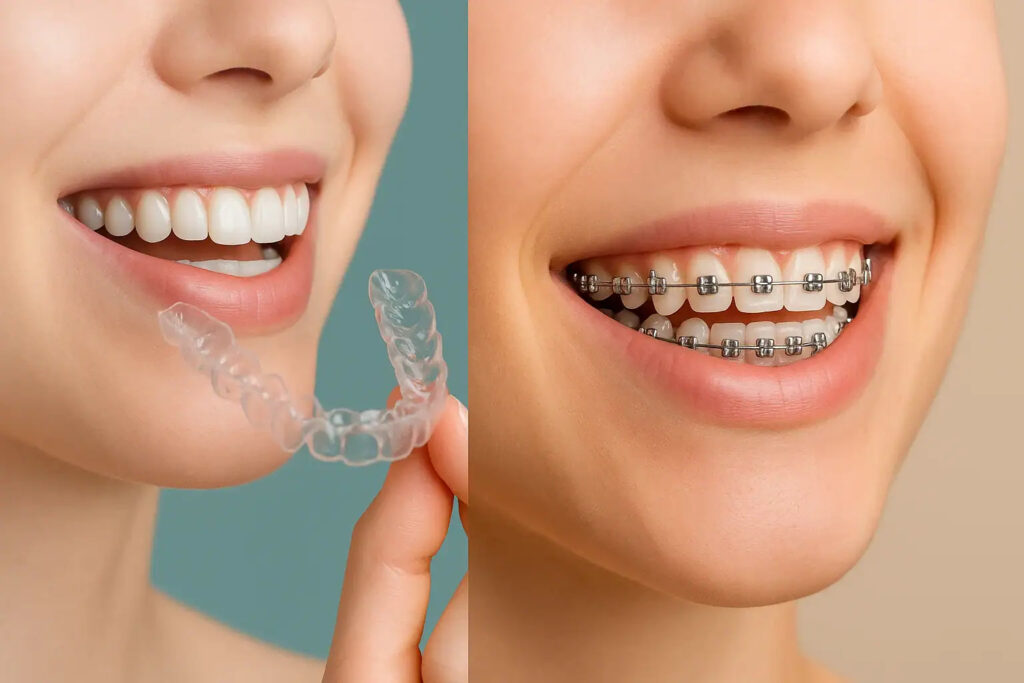
Crooked or misaligned teeth can affect not only your smile but also your oral health, bite alignment and confidence. When it comes to straightening teeth, two of the most popular options today are Invisalign and traditional metal braces.
While both treatments aim to align your teeth and improve your smile, they differ significantly in appearance, comfort, cost and effectiveness. So, which one should you choose — Invisalign or traditional braces? Let’s explore the differences to help you make an informed decision.
What Is Invisalign?
Invisalign is a modern orthodontic treatment that uses a series of clear, removable aligners to gradually move your teeth into the desired position. Made from medical-grade, BPA-free plastic, these aligners are virtually invisible when worn and can be removed for eating, brushing and flossing.
According to research , Invisalign is ideal for patients who want a discreet and comfortable orthodontic solution without the look of metal braces.
What Are Traditional Braces?
Traditional braces use metal brackets and wires that are fixed to your teeth. The orthodontist adjusts them periodically to move teeth into alignment. Braces have been used for decades and are highly effective, especially for complex bite issues or severe crowding.
Modern braces now come in ceramic or tooth-coloured options, offering a more aesthetic alternative to the classic metallic look.
Invisalign vs Traditional Braces: Key Differences
Here’s a breakdown comparing the two treatments based on the latest insights from Singapore
| Feature | Invisalign | Traditional Braces |
| Appearance | Clear, nearly invisible aligners | Metal or ceramic brackets visible on teeth |
| Comfort | Smooth plastic aligners, no wires or sharp edges | May cause irritation from brackets or wires |
| Removability | Removable for meals and oral hygiene | Fixed — can only be removed by your orthodontist |
| Treatment Duration | Typically 6–18 months (depends on complexity) | 18–24 months or longer for complex cases |
| Maintenance | Brush and rinse aligners regularly | Requires careful cleaning around brackets and wires |
| Dietary Restrictions | None — aligners are removed for eating | Avoid sticky, hard or chewy foods |
| Follow-up Visits | Every 6–8 weeks | Monthly adjustments required |
| Aesthetic Appeal | Virtually invisible | Noticeable but available in less visible ceramic options |
Cost Comparison: Invisalign vs Braces
According to research, Invisalign tends to cost more upfront than traditional braces because of the advanced digital technology and custom fabrication involved.
| Treatment | Estimated Cost Range (SGD) |
| Invisalign | $4,500 – $9,000 |
| Traditional Braces (Metal) | $3,000 – $6,000 |
| Ceramic Braces | $4,000 – $7,000 |
Note: Prices vary depending on case complexity, treatment duration and clinic expertise.
Effectiveness: Which Works Better?
A research found that traditional braces may achieve slightly more precise tooth movements for complex cases. However, Invisalign has shown excellent results for mild to moderate alignment issues, including crowding, spacing and minor bite corrections.
Invisalign is highly effective when:
- Teeth are mildly to moderately crooked
- There are small gaps or spacing issues
- The patient is disciplined about wearing aligners 20–22 hours a day
Braces are more suitable when:
- Teeth are severely crowded or rotated
- Major bite corrections (underbite, overbite) are needed
- There’s a need for precise tooth and root movement
Comfort and Lifestyle Differences
One of the biggest advantages of Invisalign is comfort and convenience. The aligners are smooth and irritation-free, whereas braces can occasionally cause discomfort from wires or bracket adjustments.
Invisalign also fits seamlessly into daily life — you can remove it before meals or important events, making it ideal for working adults and teens who prefer a discreet solution.
On the other hand, braces offer constant correction, which may be beneficial for younger patients who might forget to wear aligners regularly.
Which Option Is Right for You?
Choosing between Invisalign and traditional braces depends on your:
- Age and lifestyle
- Orthodontic complexity
- Budget and treatment goals
If aesthetics, comfort and flexibility are your top priorities — Invisalign is a great choice.
If you need a cost-effective and powerful solution for complex alignment — traditional braces may be more suitable.
A consultation with a qualified orthodontist will help determine the best treatment plan for your unique needs.
How Dental Clinic Bedok Can Help
At Dental Clinic Bedok, we offer both Invisalign and traditional braces tailored to your smile goals, budget and lifestyle. Our orthodontists use 3D scanning and digital treatment planning to ensure precise, comfortable and effective results.
Whether you’re a teen, adult or professional, we’ll help you choose the option that best fits your needs — so you can achieve a straight, confident smile.
📅 Book an appointment today to explore Invisalign or braces options in Bedok.
📍 Visit Us: Dental Clinic Bedok
📞 Call Now: +65 6690 4035

